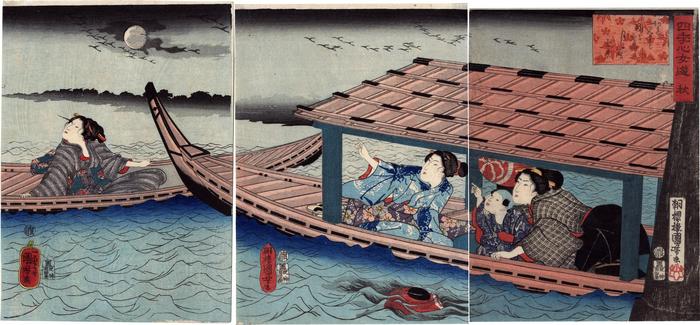Utagawa Kuniyoshi (歌川国芳) (artist 11/15/1797 – 03/05/1861)
Autumn (aki - 秋) from the series Women's Pleasures of the Four Seasons (Shiki no kokoro onna asobi - 四季心女遊)
ca 1845
7 in x 9.75 in (Overall dimensions) Japanese color woodblock print
Signed on left: Ichiyūsai Kuniyoshi ga
一勇斎国芳画
in center and right: Chōōrō Kuniyoshi ga
朝櫻樓国芳画
Artist's seal: kiri on right panel
Publisher: Aritaya Seiemon (Marks 014 - 22-064)
Censor's seal: Watari
National Diet Library
Metropolitan Museum of Art
Lyon Collection - Winter from this series
Honolulu Museum of Art This is the 'Autumn' set from an unusual group of chūban triptychs representing the four seasons. There had been a long tradition of previous artists using beautiful women as central figures wearing seasonal costumes and doing seasonal activities. Kuniyoshi was following their lead.
In Heroes and Ghosts: Japanese Prints by Kuniyoshi 1797-1861, page 131 it says: "Two boats carry three beauties and a boy who enjoy the evening cool on the Sumida river. From July through September the Sumida river was open to pleasure boats in the evening and 'taking in the evening cool' (yūsuzumi) was a popular pastime during these warm months. The roofed boat jutting out on the right is a yanebune (literally, 'roof-boat') whilst the smaller uncovered boat on the left is a chokibune (light flat-bottomed boat). The pleasure-goers are admiring the flock of wild geese in flight against an image of the full moon, a classic autumnal reference., and a clue to the subtitle of this work, Aki (Autumn). As the title of the series might imply, this print belongs to a series of four triptychs illustrating the four seasons.
"In this example Kuniyoshi experiments with the reflection of the red lantern, decorated with the kiri crest and hanging in the larger boat, on the foreground water. The artist has also cleverly guided the viewer's attention to the moon via the curved form of the yanebune and uses bokashi (gradated colour printing) to render the impressions of clouds before the moon. Moreover, it is interesting that Kuniyoshi has not only employed three different signatures styles in this triptych but also placed them in three varying cartouches. The bridge support visible on the right is also found in a single sheet version of this series illustrating the four seasons. The verse on this print was written by Haruhiro Genkō.
"There are three editions of this print. In the first edition the lantern's reflection on the water is printed in red; the example reproduced here represents the second edition and a third edition is recognizable by the omission of the additional black clouds near the moon."
****
There are copies of the center and right panels of this triptych at the Ishibi Prefectural Museum.
****
Illustrated:
1) in color in a two page spread in The Decadents by Jūzō Suzuki and Isaburō Oka, Kodansha, 1976, pp., 56-57.
Suzuki wrote: "During the Kōka era, Kuniyoshi was fond of doing bijin-ga in the form of aiban triptychs. This work is perhaps the best, artistically, of a set of four representing the four seasons, and skillfully conveys a pervasive autumnal atmosphere. The lantern in the water was probably intended as a reflection of the lantern in the boat. The wild geese that are attracting the attention of the women and child as they fly across the moon are a typical symbol of autumn." (p. 56)
2) In color in 歌川国芳展: 生誕200年記念 Utagawa Kuniyoshi: Exhibition to Commemorate the 200th Anniversary of his birth, 1996, #161, p. 127.
3) In color in in Kuniyoshi by Jūzō Suzuki, Heibonsha Limited, Publishers, 1992, no. 235.
4) in black and white in Utagawa Kuniyoshi, Springfield Museum of Art, 1980, #113.
5) in color in Heroes and Ghosts: Japanese Prints by Kuniyoshi 1797-1861 by Robert Schaap, Hotei Publishing, 1998, page 131, no. 132.
6) in color in Utagawa Kuniyoshi: 342 Color Paintings [sic] of Utagawa Kuniyoshi by Jacek Michalak, Kindle Edition, 2022, unpaginated.
Aritaya Seiemon (有田屋清右衛門) (publisher)
beautiful woman picture (bijin-ga - 美人画) (genre)
boshi-e (母子絵) (genre)
kari (wild geese - 雁) (genre)
